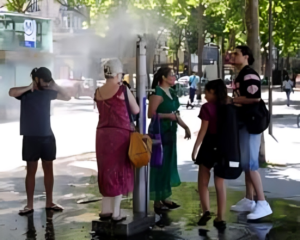Europe’s Unrelenting Scorch: Inside the Deadly Heatwave Gripping the Continent
Europe is in the grip of an unprecedented heatwave, with temperatures soaring above 40 °C in cities from Madrid to Paris and beyond. As sweltering daytime highs give way to nights that barely cool down, the human and environmental toll is mounting. This article delves into what’s driving this extreme heat, who is bearing the brunt, and why forecasts suggest the worst may still lie ahead.
Why Temperatures Have Spiked So Dramatically
Climate scientists point to a confluence of factors:
- Jet stream disruption: A stalled high‑pressure ridge is funneling hot air northward from Africa, while preventing cooler Atlantic breezes from moderating temperatures.
- Urban heat islands: Dense concrete and asphalt trap heat in metropolitan areas, pushing city temperatures several degrees higher than surrounding countryside.
- Climate change trend: Decades of rising greenhouse gas concentrations make extreme heat events more frequent, intense, and long‑lasting.
Small rural villages report fields already parched, while city dwellers find even shaded parks offering little respite.

Who Is Suffering the Most
While no one is immune to soaring temperatures, certain groups and regions face heightened risks:
- Elderly and very young
- Outdoor workers (construction crews, delivery riders)
- Low‑income households lacking air conditioning
- Individuals with chronic illnesses (heart, respiratory conditions)
Across southern Spain, ambulances are stretched thin responding to heat‑related emergencies. In northern France, several deaths have already been attributed to the relentless heat. Medical teams urge everyone to stay hydrated, avoid the midday sun, and check on vulnerable neighbors.
—
Real‑Life Story: Ana’s Vineyard at Risk
In Portugal’s Alentejo region, winemaker Ana Ferreira watches her family’s century‑old vines wilt in record temperatures. “By noon, even the soil feels like an oven,” she says. Loss of yield could reach 30 % this season, threatening both livelihoods and a celebrated regional heritage.
—
Why It Could Get Even Worse
Meteorological models warn that the current stagnant high‑pressure system may persist for several more days. Meanwhile:
- Soil moisture deficit from a dry winter and spring allows ground to heat up faster.
- Lack of nighttime relief: Overnight lows above 25 °C prevent the body from recovering.
- Feedback loops: Hotter ground temperatures reinforce the high‑pressure ridge, locking in the heat.
Public health agencies forecast additional heat alerts in central and eastern Europe, with Poland, Germany, and Italy next in the firing line.
—
Coping Strategies and Community Response
Local governments and communities are mobilizing to reduce the human toll:
- Cooling centers: Air‑conditioned public buildings open 24/7 as shelters.
- Water distribution points: Volunteer networks handing out bottles in parks and transit stations.
- Night‑shift adjustments: Industries shifting outdoor tasks to pre‑dawn hours.
- Awareness campaigns: Text alerts and social media tips on recognizing heatstroke.
Technology has also stepped up: smartphone apps now map shaded routes for pedestrians and cyclists.
—
Lessons for the Future
This deadly episode underscores a pressing need for adaptation:
- Urban planning overhaul: Green roofs, reflective pavements, and expanded tree canopies.
- Building upgrades: Better insulation, passive cooling designs, and affordable air‑conditioning programs.
- Agricultural resilience: Drought‑tolerant crop varieties and soil conservation techniques.
As Europe’s summers grow hotter, long‑term strategies will be essential to safeguard health, economies, and ecosystems alike.
Conclusion
The current heatwave is a stark reminder that extreme weather events are becoming the new normal. While immediate relief measures can save lives today, only bold climate action and adaptive planning will ensure Europe is prepared for the sweltering summers of tomorrow.